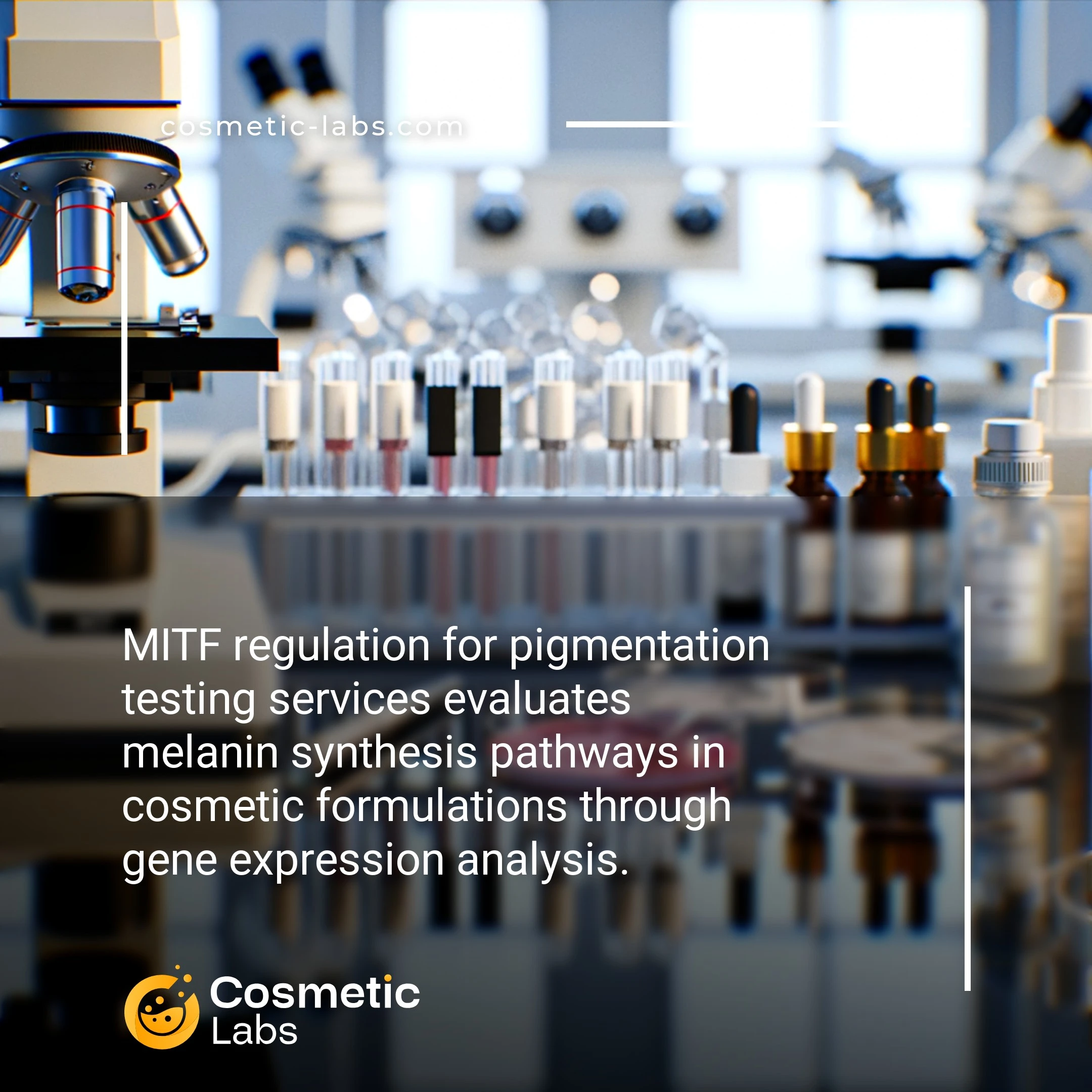MITF Regulation Testing Services for Pigmentation Products

What is MITF regulation?
MITF regulation testing for pigmentation measures how cosmetic ingredients affect the microphthalmia-associated transcription factor, which controls melanin production in skin cells. Labs use cell culture assays and gene expression analysis to evaluate whether your whitening serums or tanning products actually increase or decrease melanocyte activity at the molecular level. This testing reveals the biological mechanism behind pigmentation changes, helping you validate ingredient efficacy claims before market launch.
Why do you need this service?
Cosmetic labs use MITF pathway analysis to validate whitening ingredients and anti-aging formulations before market launch. Teams measure melanocyte activity changes in response to botanical extracts, peptides, and vitamin C derivatives, generating quantifiable efficacy data that supports product claims and regulatory submissions. This testing approach helps brands demonstrate ingredient performance through standardized protocols that track pigmentation responses at the cellular level.
Who provides MITF regulation services?
All cosmetic labs providing MITF regulation services
There is no company providing these services at the moment.
MITF Regulation Testing for Pigmentation Products
Labs analyze MITF (Microphthalmia-associated Transcription Factor) regulation to measure how cosmetic ingredients affect melanin production pathways. This transcription factor controls melanocyte development and pigment synthesis, making it a key target for brands developing skin brightening or tanning products.
Melanogenesis Pathway Analysis
Testing facilities examine how active ingredients influence MITF expression levels in melanocyte cell cultures. Labs use RT-PCR and Western blot techniques to quantify changes in MITF protein and mRNA levels after ingredient exposure.
Standard testing protocols include:
- Dose-response curves at 24, 48, and 72-hour intervals
- Tyrosinase activity measurements downstream of MITF
- Melanin content quantification using spectrophotometry
- Cell viability assessments to confirm safety thresholds
Regulatory Documentation and Claims Support
Labs provide detailed reports showing MITF modulation data that support product efficacy claims. These studies help brands demonstrate ingredient activity for regulatory submissions and marketing materials.
Testing outputs include:
- Statistical analysis of MITF expression changes
- Comparative studies against reference compounds
- Photographic documentation of pigmentation effects
- GLP-compliant protocols for international markets
Partner with specialized labs on our platform to validate your pigmentation-active ingredients through proven MITF regulation assays.
Applications of MITF Regulation Testing in Pigmentation Product Development
Beauty brands rely on MITF regulation testing for pigmentation to validate their whitening and brightening formulations before market launch.
Skin Brightening Ingredient Validation
Labs evaluate how active ingredients modulate MITF expression in melanocytes using RT-PCR and Western blot analysis. This testing identifies compounds that downregulate MITF transcription factor activity, leading to reduced melanin synthesis. Brands use these results to optimize ingredient concentrations and combination ratios in their formulations.
Testing protocols measure MITF mRNA levels at 24, 48, and 72-hour intervals. Labs also assess downstream effects on tyrosinase activity and melanin content. These measurements help brands understand ingredient efficacy timelines and establish appropriate product usage recommendations.
Formulation Optimization and Safety Assessment
Product developers submit complete formulations to test MITF pathway interference alongside cytotoxicity screening. Labs use cell viability assays combined with MITF expression analysis to identify the optimal balance between efficacy and safety. This dual approach prevents formulations that might achieve whitening through cellular damage rather than targeted melanogenesis inhibition.
Testing includes dose-response curves across different concentrations to establish minimum effective concentrations and maximum safe usage levels. Labs provide detailed reports showing MITF suppression percentages alongside cell survival rates, enabling brands to make informed formulation decisions.
| Testing Parameter | Measurement Method | Typical Timeline | Key Output |
|---|---|---|---|
| MITF mRNA Expression | Real-time PCR | 24-72 hours | Fold change vs control |
| MITF Protein Levels | Western blot | 48-96 hours | Protein concentration |
| Melanin Content | Spectrophotometry | 5-7 days | Melanin reduction % |
| Cell Viability | MTT assay | 24-48 hours | IC50 values |
Ready to validate your pigmentation formulation’s MITF regulation effects? Contact specialized labs on our platform to discuss your testing requirements and timeline.
